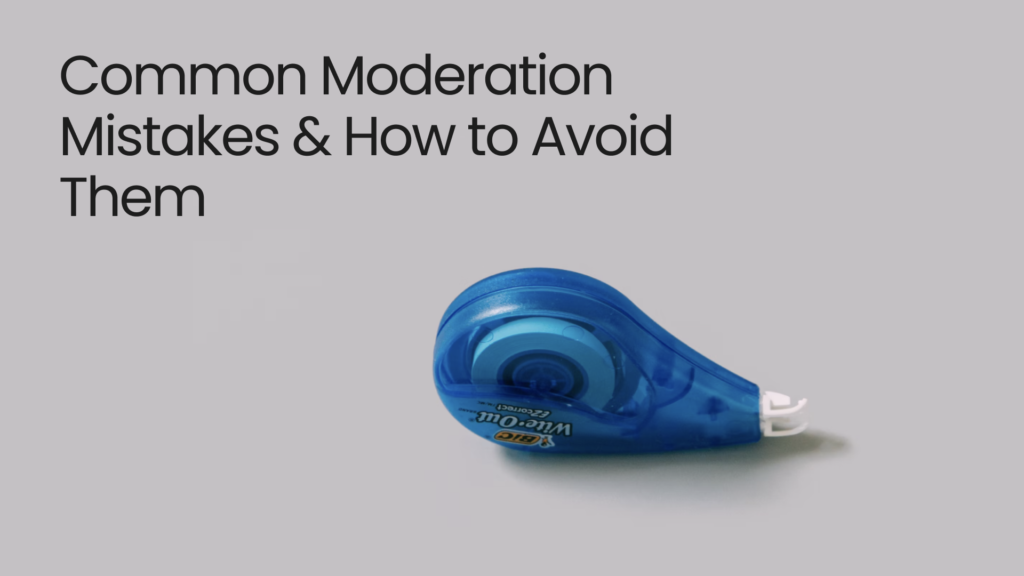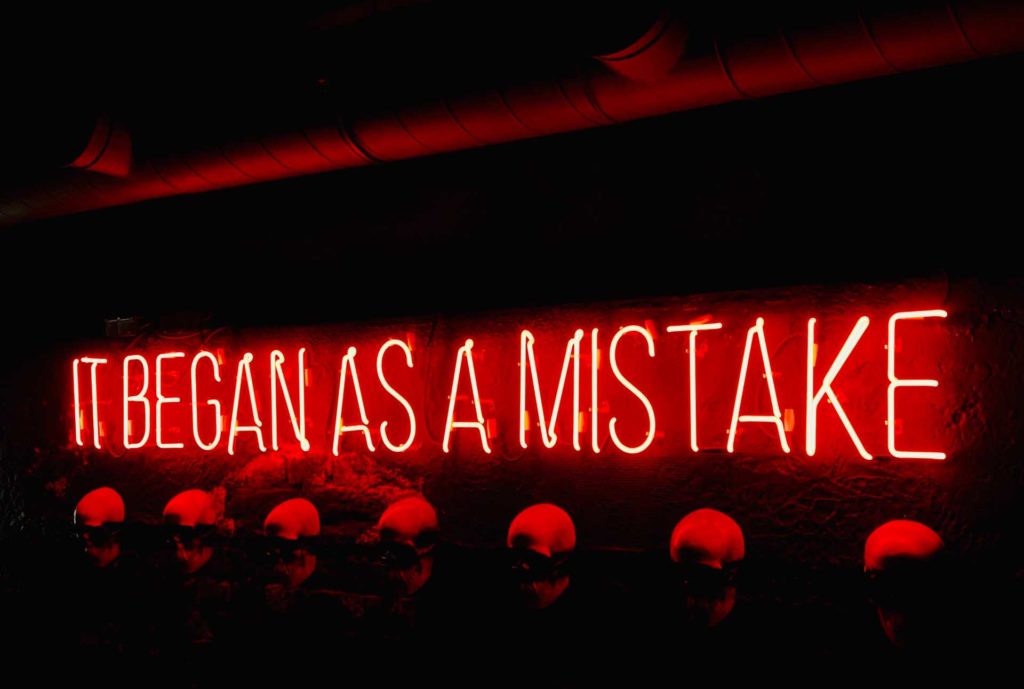10 common content moderation mistakes (and how to avoid them)
December 24, 2023 | UGCContent moderation is a delicate balancing act. On one hand, you must ensure that platforms remain safe, inclusive, and engaging for all users, but on the other, you want people to feel free to express themselves. Finding this balance is a task fraught with complexities and challenges. From understanding the subtle intricacies of human communication to adapting to the diverse cultural norms of a global audience, content moderators must navigate a series of hurdles each day.
As you might expect, with so many challenges comes the opportunity for mistakes to be made, which can hinder the effectiveness of your moderation efforts. These missteps can have far-reaching consequences, from eroding user trust to inadvertently harming the very community your platform seeks to protect.
In this guide, we will explore the top 10 content moderation mistakes and draw from our nearly two decades of moderation experience to provide insights on how to avoid them.
1. Over-reliance on automation
One of the most significant challenges in modern content moderation is the over-reliance on automation. While AI and machine learning tools are incredibly efficient in processing large volumes of content, they lack the nuanced understanding of human moderators.
AI systems on their own are great for moderating at scale, but without the balance of human insight, you soon see their limitations as they fail to correctly interpret context, sarcasm, and cultural subtleties.
The current solution lies in a hybrid approach that leverages the speed and efficiency of AI for initial filtering and employs human judgment for more complex and nuanced content review. Continuously updating AI algorithms based on insights from human moderators can enhance their accuracy. What’s more, training these systems with diverse datasets can help minimize biases and improve contextual understanding.
2. Inconsistent moderation standards
Another common mistake is inconsistency in the standards you uphold. Vague guidelines or differing interpretations among moderators can lead to unfair treatment of users, undermining trust and potentially driving those users away for good.
To combat this, platforms need to develop clear, detailed moderation guidelines that are easily interpreted and leave little room for ambiguity. To this end, regular training sessions and unbiased decision trees for moderators are essential to ensure a consistent understanding and application of these guidelines. A quality assurance process to review moderated content is also important for maintaining consistency.
“Consistency in moderation isn’t just about sticking to the rules; it’s about embodying the spirit of your community,” says Alexandra Popken, WebPurify’s VP of Trust & Safety. “At WebPurify, we strive to ensure that every moderator not only understands our clients’ community guidelines but also the context and standards behind them. It’s this deep understanding that helps us apply our policies fairly and thoughtfully, ensuring that your platform remains a safe and welcoming space for all.”
Finally, encouraging open communication among content moderators, and a productive feedback loop with the client, can foster a unified approach to decision-making, particularly in complex or borderline cases.
3. Ignoring cultural sensitivities
The internet made the world smaller, and it’s now a regular occurrence to be interacting with people from all over the world. This, of course, presents challenges for moderation teams because what is considered acceptable in one culture might be seen as offensive in another. For example, Western cultures tend to have a more liberal attitude towards adult content, whereas many Middle Eastern cultures tend to lean more conservative. This cultural disparity can then upset certain user groups and potentially escalate into larger conflicts or public relations crises for your brand.
To address this, platforms must have a strategy in place that addresses cultural nuances. This typically involves a multi-pronged approach of supplementing moderator and team training, hiring diverse employees where possible, conducting user research and focus groups, and consulting external experts local to each region.
“In today’s interconnected world, cultural sensitivity is not just a good practice, it’s a necessity,” Alex says. “It’s important that we not only broaden our understanding of different cultures but also deepen our empathy towards the myriad ways people communicate and express themselves. This appreciation for diversity is instrumental in helping us moderate with respect and accuracy.”
4. Not evaluating moderation guidelines regularly
A critical aspect in content moderation that’s often overlooked is the need for regular evaluation of moderation guidelines. The way we communicate online is in a constant state of flux, with social norms and user behaviors, laws and regulations evolving rapidly. What was acceptable yesterday might be unacceptable today. Therefore, it’s vital for companies to ensure their moderation policies are agile and adaptable.
Regular reviews and updates of guidelines should be an integral part of the moderation process. This approach not only helps you stay relevant but also enables you to effectively manage emerging trends and challenges in user-generated content.
What’s more, involving moderators in the policy update process can provide practical insights, ensuring that your guidelines are grounded in the realities of day-to-day moderation challenges.
5. Failing to provide clear communication to users
Failing to provide transparency and clarity about content policies in your communication with users is one of the easiest mistakes for brands to make, but it’s also the simplest to rectify. When your communication isn’t clear, users are left in the dark about what constitutes acceptable content, leading to confusion and frustration, especially when their content is moderated without a clear explanation.
To prevent this, platforms need to articulate their content policies in an easily understandable manner, and have an appeals process that is straightforward and staffed with a fast turnaround time. A simple page on your website setting out your policies can go a long way as well as response templates that communicate the reasons behind your moderation decisions. This not only helps in setting the right expectations but also fosters a sense of fairness and respect among your users.
“When users understand not just the ‘what’ but also the ‘why’ of your moderation actions, it creates a foundation of trust and understanding,” Alex says. “In our experience, customers generally want to adhere to guidelines – they just need to understand them.”
6. Neglecting user feedback
Providing avenues for CSAT (customer satisfaction) and qualitative user feedback regarding moderation decisions can further enhance transparency and user engagement. User feedback can be a goldmine of insight into the effectiveness and reception of your moderation policies because your users are the first to notice and point out the gaps or inconsistencies. By actively seeking, listening to, and incorporating their feedback, platforms can adapt and improve their policies and processes.
This approach not only helps in identifying blind spots in your moderation process but also in understanding the community’s perspective. Regular surveys, community forums, and feedback channels are effective ways to gather and analyze user feedback, ensuring your moderation strategy remains aligned with the community’s needs and expectations.
7. Underestimating the impact of moderation on moderators
A commonly overlooked aspect of content moderation services is the significant impact it can have on the moderators themselves. Content moderators can be exposed to disturbing and harmful content, which can take a mental toll. It’s crucial for platforms and content moderation partners to acknowledge and address the potential psychological impact of this work. Providing moderators with adequate support, such as access to mental health resources, regular breaks, and a supportive work environment, is essential.
In addition , offering training in handling traumatic content and ensuring tools are in place to minimize exposure to distressing submissions can help mitigate these challenges. By caring for the wellbeing of their moderators, platforms not only maintain a healthier work environment but also ensure a higher quality of moderation.
WebPurify partnered with Silver Oak Health to create an Employee Wellbeing and Assistance Program (EWAP) that is focused on the unique mental health needs of content moderators. Our mental health support provides 24/7 counseling services, mindfulness and wellbeing training, emergency support and a comprehensive set of tools and awareness education. Download our ebook on Best Practices for Mental Wellness in Content Moderation to find out more.
8. Not optimizing your moderation strategy alongside growth in your user base
As online platforms grow, so does the volume of content that needs to be moderated. A common mistake platforms make is not pivoting their moderation strategy to account for this scale. This oversight can lead to violative content slipping through the cracks, or benign content being unnecessarily moderated, introducing risk and friction for your user base.
A large part of avoiding this is by working smarter, not harder, and investing in more advanced technology. Companies overreliant upon blunt block lists or moderating every submission manually should invest in automation and AI – and if they can’t build it internally, shop around for what they can buy externally. Introducing an AI confidence score for submissions helps companies send just the gray area content for human review, and reduce needless operational costs.
Another item that should be looked at is tooling efficiency. If a moderation tool suffers from poor load times or requires a moderator to click multiple times to make a decision, it’s not optimized for productivity. Other features like an escalation queue or ability to filter segments of content by sub-category (policy, language, etc.) can help with processing speeds and accuracy.
9. Lack of transparency in your moderation processes
Transparency in moderation processes is crucial for building and maintaining the trust of your community. When users don’t understand how and why their content is moderated, it can lead to mistrust and dissatisfaction. To foster transparency, brands need to clearly communicate their moderation policies, procedures, and the rationale behind decisions. This includes explaining the mechanisms for flagging content, how decisions are made, and the steps for appealing moderation decisions.
Openly discussing the challenges and complexities of content moderation can also help your users understand the intricacies involved in maintaining a safe online environment. Transparency not only builds trust but also encourages users to adhere to community guidelines.
10. Over- and under-moderation
Finding the right balance of moderation is a delicate task. Over-moderation can stifle community engagement and creativity, leading to a bland or restrictive environment. On the other hand, under-moderation can allow harmful or offensive content to proliferate, damaging your community’s atmosphere and deterring users.
Striking a balance requires a nuanced understanding of the community’s nature and needs. Regularly reviewing moderation outcomes, soliciting community feedback from users and experts, and being flexible in policy enforcement can help you achieve this balance. It’s about creating a space that is both safe and vibrant, where creativity can flourish within the bounds of respect and safety.


